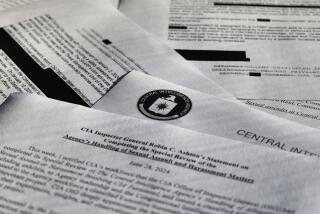BATTLEGROUND BERLIN: CIA vs. KGB in the Cold War.<i> By David E. Murphy, Sergei A. Kondrashev and George Bailey</i> .<i> Yale University Press: 530 pp., $30</i>
We came to review this book about the same way its authors did to write it: as veterans from opposing sides of the Cold War with differing convictions and experience. But when we came together, we found that our views coincided, that we had focused to a surprising degree on the same points, had found no important errors and had learned things we hadn’t known. The authors of “Battleground Berlin” have produced a balanced and authoritative history that spans a crucial time in a crucial place.
The Cold War might have turned hot in many places in the world, but nowhere more often than in Berlin. Military forces of East and West squared off in that divided city for more than 40 years, while their governments carried out policies that the other sides felt as threats. Crisis followed crisis as the Soviet leaders tried to squeeze the Western occupiers out of the city. Again and again, the United States beefed up its forces and prepared military responses; the Soviet Army held exercises that the West saw as threatening; and diplomats tried to find peaceful explanations. At one tense moment, pictured on the book’s dust jacket, hostile tanks faced each other almost nose to nose. That 1961 showdown at the Friedrichstrasse control point, known as Checkpoint Charlie, occurred when Allied forces threatened to destroy the barrier if the East Germans closed the crossing. After a standoff, both sides withdrew, though “there is no single documented account of the circumstances that finally resolved the crisis,” the authors write.
The gift of hindsight has led some Western writers to suggest that there never was a real threat in Berlin because shooting never broke out between the sides. Not true: In those tense moments, even the leaders were unsure about what they would do next or how to avoid fatal missteps. Each side urgently needed to know what the other was really planning behind its public posturing, and each side called on its intelligence services to supply that knowledge.
With Cold War archives slowly beginning to crack open, intelligence veterans from opposing sides have joined together to show how their services rose to the challenge in “Battleground Berlin.” We know them, and they are unusually well qualified: David Murphy was a field operator directing the CIA’s Berlin base, and no one was more perceptive and informed than Sergei Kondrashev, a supervisor for the KGB in Moscow, who frequently came to Berlin on special missions and George Bailey, a reporter and former director of Radio Liberty.
To write “Battleground Berlin,” each returned to his former service to pry out secret documents to support his memories and became involved in long uphill struggles through bureaucratic barriers. We know these barriers: A couple of years ago, for example, Markus Wolf tried to get the KGB’s successors in Moscow to release (for his own memoir) a document that he had supplied for them, only to run up against a stone wall. It is to the authors’ credit that they sprang loose as much as they did for this book.
“Battleground Berlin” begins with the arrival of the American and Soviet intelligence services in Berlin in 1945, the early years when people could move more or less freely between its Eastern and Western sectors, and ends with the building of the wall in 1961. It’s a logical stopping point because the wall, by cutting off personal meetings with spies on the other side, “turned the operational world upside down . . . and ended Berlin’s status as a unique operational asset in the Cold War.”
The wall, which solved in one stroke the increasingly desperate crisis for West and East of a mass exodus westward from East Germany, had been prepared by a handful of top East German leaders and hit the KGB and CIA as a surprise. Wolf’s intelligence group, like the CIA, suddenly had to scramble to find new ways to communicate with its agents on the other side; incidentally, both sides often arrived at the same solutions, such as transmitting messages along infrared light beams.
The authors give us fresh illustrations of problems that have always beset intelligence services. One is the curse of Cassandra: our inability to get political leaders to heed our information. Kondrashev laments “the inability of Stalin and his successors to accept and act on intelligence contrary to their preconceptions.
“Perhaps the most frightening aspect of the Cold War in Berlin was how poorly informed the Soviet leaders were, even after receiving mountains of secret information . . . much of it from the offices of Western leaders themselves.”
Wolf was chilled. Knowing that great powers have often gone to war to protect the fragile prestige of their leaders, he watched as Nikita Khrushchev laid his prestige on the line to intimidate the Western occupiers out of Berlin, although Wolf’s forces were supplying Khrushchev’s KGB with solid evidence that such tactics wouldn’t work and that it was dangerous to try. During the 1958 crisis, for example, Wolf gave the Soviets secret NATO contingency plans, code-named “Live Oak,” that left no doubt about NATO’s readiness to react with military force. From “Battleground Berlin,” Wolf learned that his “Live Oak” information was passed too late to Khrushchev; but he had passed other such information and nothing restrained Khrushchev from pressuring the West for years and creating a whole series of war-threatening crises.
Another permanent intelligence problem arises from the spymasters themselves: their tendency to slant or withhold information to avoid displeasing their political leaders. “Few Soviet intelligence officers dared deliver unpleasant messages to Stalin or Khrushchev lest they spend the rest of their days in the Gulag,” Kondrashev tells us, and “this attitude and the consequent lack of Soviet understanding of the American perspective led both sides to the brink of war more than once.” The KGB in Berlin misrepresented or failed to convey to Moscow information as important as how the Allied forces could be able to airlift supplies to a blockaded Berlin or how the North Korean attack on the South (approved by Stalin) was seen by Western allies as a forerunner to an attack on the West and encouraged the rearming of West Germany, dimming any realistic prospects for reunification.
For the first time, we get the full story here of the famous Berlin Tunnel, the brilliant operation in the mid-1950s in which the Americans dug a 400-yard tunnel into East Berlin to tap into military phone lines in the Soviet sector. A myth had arisen in the West about the tunnel’s usefulness, and here the authors combine to explode it. After learning that the KGB had known all along about the tunnel (from their mole in British Intelligence, George Blake, who was handled by Kondrashev) but had allowed it to run for more than a year, some Western pundits, abetted (or perhaps inspired) by mischievous disinformers from Moscow, asserted that the tunnel produced only trivial tidbits of information and, moreover, that the KGB “controlled” what the Americans could hear and even inserted false information to deceive them.
Murphy tells us what the CIA really got from the tunnel, and it is a stunning list (here strangely relegated to an appendix), while Kondrashev, a former chief of the KGB’s disinformation work, states flatly that no deception was even tried because the KGB had to protect Blake. Even within the KGB, only a few people knew about this important mole, much less what he had reported about the tunnel. (Although Wolf had an inkling from a boastful KGB general that they had a good British source, he was never told about the tunnel.) Not even the Soviet military commanders whose phones were tapped were aware of it. Who, then, could have controlled what was said over scores of tapped lines serving seven Soviet armies in Germany? Who could have chattered deceptively about important matters, in ways that the Americans could not detect (and tumble to the game) by checking other sources?
Wolf was interested to find in this book the first public admission of things he had long known: that two ostensibly independent anti-Communist action organizations were, in fact, CIA projects. To this day, Wolf is heckled by survivors of these organizations (the Investigating Committee of Free Jurists, Untersuchungsausschuss Freier Juristen, and the Fighting Group Against Inhumanity, Kampfgruppe gegen Unmenschlichkeit) who protest against the East German imprisonment of their captured members in the East. The CIA now admits that it sponsored both groups, even having invented one of them, and used their members to spy and prepare wartime sabotage.
Much is missing, of course, from “Battleground Berlin.” While the book describes the KGB use of Wolf’s East German intelligence service, it barely alludes to the CIA’s relationship with Reinhard Gehlen’s West German organization, the Federal Intelligence Service. And while Murphy admits the vulnerability of the CIA’s work in Berlin, its pressures and “frenetic pace” that left some of its spies dangerously exposed, we learn nothing (except when the book tells us about a spy’s arrest) of how, and with what success, this was exploited by the several KGB and MfS (Ministry for State Security) units that were watching the CIA’s Berlin activity.
And if readers are looking for a two-sided treatment of real-life spy stories, they will be frustrated. From the American side come glimpses of a lot of spies, such as the cleaning woman “Frau K” who stole important secrets from the desk of a senior Soviet officer, “Fatso” and others who ran into counterspy traps, and “Sniper,” who escaped to the Western sector after spying anonymously for the Americans from inside Polish Intelligence. But even these stories are like dropping one shoe: With four or five exceptions, there’s not a word about how they looked from the Soviet side.
What we get instead is description of political reports and analyses that the KGB in Berlin sent to Moscow (several of them recognizably obtained from Wolf’s East German service, by the way). There are more than 100 of them, and in a few chapters they appear in such numbing succession as to clog the narrative flow. But they enlighten the history of Berlin’s political crises. They show, for example, that the KGB never had any doubt about what caused the June 1953 worker uprisings in East Berlin (the announcement to workers of a “New Course” involving drastically increased production norms). And though they immediately charged the Westerners of instigating or abetting the riots, they had to do so to help their leaders rationalize their own failure. In reality, the East German leadership, the KGB and the CIA were all caught flat-footed.
Anyone interested in the history of espionage in the Cold War will ask: Who were the sources of these secret KGB reports? One of these reports “represented an enormous effort by many highly placed KGB agents who were, in [KGB chairman] Shelepin’s words, ‘employed in the foreign ministries, general staffs, and other government agencies of the Western powers as well as the NATO structures.’ ” It would be good to know more: if not exactly who they were, at least something about their personalities, why they betrayed their trust and how the KGB recruited and handled them.
Take the French, for example. We learn that in the early 1950s, after the KGB lost great British agents Kim Philby, Guy Burgess, Donald Maclean and John Cairncross, French spies supplied the KGB’s best information on high-level Western thinking. And here we get vague allusions to some of them, including a diplomat in Berlin. If French counterintelligence ever uncovered these spies, they have never revealed it publicly, and we are left to wonder.
Sometimes “Battleground Berlin” gives only the number of spies. The CIA took pride in keeping in touch, despite the wall, with “more than 25 agents” and again, afterward, with “more than 30.” But who were they, and what could they report? Numbers don’t matter. Gehlen’s West German intelligence organization had hundreds of spies in the East in the Cold War’s early years, but Soviet and East German counterintelligence knew about most of the them, controlled many and, when it served some purpose, would round them up, scores at a time. Wolf is often asked how many spies his intelligence forces were running in West Germany, and he usually answers “about a thousand,” but the question misses the point. One hundred spies may be better than 1,000, and 10 may be better than 100.
Of Wolf’s many spies in the West, few could compare to Rainer Ruepp in NATO, Gabriella Gast high in the Federal Intelligence Service , Guenther Guillaume at the right hand of Chancellor Willy Brandt, the secretaries of certain high political figures or even the low-level messenger in the West German Interior Ministry, code-named “Minister,” who knew little but had the key to the ministry’s courier bag and its secret contents.
Still, “Battleground Berlin” breaks new ground, and if it is neither the complete story nor the last word, it has pointed the way for others. Documents without eyewitness interpretation can be sterile and misinterpreted; personal memories without documents are inevitably selective and sometimes self-justifying. The authors have successfully brought them together. We hope that more documents can be sprung from both sides while there is time for the veterans to breathe life into them, before veterans like us fade from the scene.
More to Read
Sign up for Essential California
The most important California stories and recommendations in your inbox every morning.
You may occasionally receive promotional content from the Los Angeles Times.










